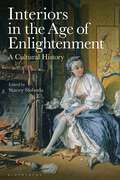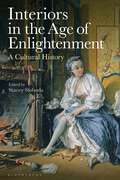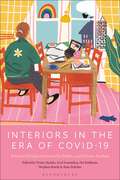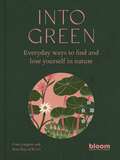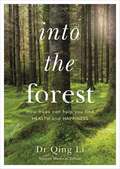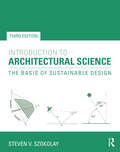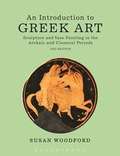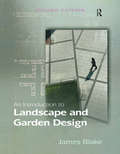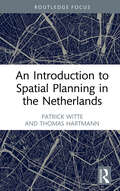- Table View
- List View
Interiors in the Age of Enlightenment: A Cultural History
by Edited by Stacey SlobodaInteriors in the Age of Enlightenment provides a comprehensive and interdisciplinary overview of the cultural history of interior design and interior spaces from 1700 to 1850.Considering the interior as material, social and cultural artefact, this volume moves beyond conventional descriptive accounts of changing styles and interior design fashions, to explore in depth the effect on the interior of the materials, processes, aesthetic philosophies and cultural attitudes of the age.From the Palace of Versailles to Virginia coffeehouses, and from Chinoiserie bathhouses to the trading exchanges of the West Indies, the chapters in this book examine a wide range of themes including technological advancements, public spaces, gender and sexuality, and global movements in interior designs and decorations. Drawing together contributions from leading scholars, this volume provides the most authoritative and comprehensive survey of the history of interiors and interior architecture in the long eighteenth century.
Interiors in the Age of Enlightenment: A Cultural History
Interiors in the Age of Enlightenment provides a comprehensive and interdisciplinary overview of the cultural history of interior design and interior spaces from 1700 to 1850.Considering the interior as material, social and cultural artefact, this volume moves beyond conventional descriptive accounts of changing styles and interior design fashions, to explore in depth the effect on the interior of the materials, processes, aesthetic philosophies and cultural attitudes of the age.From the Palace of Versailles to Virginia coffeehouses, and from Chinoiserie bathhouses to the trading exchanges of the West Indies, the chapters in this book examine a wide range of themes including technological advancements, public spaces, gender and sexuality, and global movements in interior designs and decorations. Drawing together contributions from leading scholars, this volume provides the most authoritative and comprehensive survey of the history of interiors and interior architecture in the long eighteenth century.
Interiors in the Era of Covid-19: Interior Design between the Public and Private Realms
by Penny Sparke,Ersi Ioannidou, Pat Kirkham, Stephen Knott, and Jana ScholzeThe Covid-19 lockdowns caused people worldwide to be confined to their homes for longer and on a greater scale than ever before. This forced many unprecedented changes to the way we treat domestic space – as relationships shifted between the public and the private worlds, and homes were rapidly adapted to accommodate the additional roles of schools, offices, gyms, restaurants, making-spaces and more. Above all, our understanding of the home as a site to support and enhance the well-being of its inhabitants changed in a variety of novel ways. Interiors in the Era of Covid is a collection of essays which explore the complex ways in which our inside spaces (contemporary and historical) have responded to Covid-19 and other human crises. With case studies ranging from US and Europe to Japan, China, Colombia, and Bangladesh, this is a truly global work which examines wide-ranging subjects from home-working and home technologies, to the impact of lockdown on people's identities, gender roles in the home, and the realities of domestic living with Covid in refugee camps. Exploring the roles played by designers (both amateur and professional) in accommodating changing requirements and anticipating future ones – whether Covid or beyond – this book is a must-read for students and researchers in interior design, architecture, architectural and design history, and anyone interested in the home and the relationships between health and design.
Interiors in the Era of Covid-19: Interior Design between the Public and Private Realms
The Covid-19 lockdowns caused people worldwide to be confined to their homes for longer and on a greater scale than ever before. This forced many unprecedented changes to the way we treat domestic space – as relationships shifted between the public and the private worlds, and homes were rapidly adapted to accommodate the additional roles of schools, offices, gyms, restaurants, making-spaces and more. Above all, our understanding of the home as a site to support and enhance the well-being of its inhabitants changed in a variety of novel ways. Interiors in the Era of Covid is a collection of essays which explore the complex ways in which our inside spaces (contemporary and historical) have responded to Covid-19 and other human crises. With case studies ranging from US and Europe to Japan, China, Colombia, and Bangladesh, this is a truly global work which examines wide-ranging subjects from home-working and home technologies, to the impact of lockdown on people's identities, gender roles in the home, and the realities of domestic living with Covid in refugee camps. Exploring the roles played by designers (both amateur and professional) in accommodating changing requirements and anticipating future ones – whether Covid or beyond – this book is a must-read for students and researchers in interior design, architecture, architectural and design history, and anyone interested in the home and the relationships between health and design.
Intermodal Freight Transport
by David LoweThis book provides an introduction to the whole concept of intermodal freight transport, the means of delivering goods using two or more transport modes, recounting both European experience and UK developments and reporting on the extensive political influences on this form of transport. This is placed into context with reference to developments in North America and Asia.Detailed explanations are given of the road and rail vehicles, the loading units and the transfer equipment used in such operations. In particular, the role of the Channel Tunnel in the development of long-haul combined transport operations between the UK and Europe is considered.
Intermodal Freight Transport
by David LoweThis book provides an introduction to the whole concept of intermodal freight transport, the means of delivering goods using two or more transport modes, recounting both European experience and UK developments and reporting on the extensive political influences on this form of transport. This is placed into context with reference to developments in North America and Asia.Detailed explanations are given of the road and rail vehicles, the loading units and the transfer equipment used in such operations. In particular, the role of the Channel Tunnel in the development of long-haul combined transport operations between the UK and Europe is considered.
International Perspectives on the Belt and Road Initiative: A Bottom-Up Approach (Planning, Heritage and Sustainability)
by Shannon Morreira Hao Wu Wenqi Lin Sun Sheng Han Bo QinInternational Perspectives on the Belt and Road Initiative investigates the most significant global‐scale international trade expansion and capital investment programme since the Second World War. This book focuses on the multi-national perspectives of the Belt and Road Initiative (BRI) in order to interrogate the Chinese government’s representation of it as a symbol of ‘peace, cooperation, development and mutual benefit.' With specific focus on the interrelationship between geopolitics, infrastructure investments and urban regional development, the book reflects on 12 countries’ experiences in depth, including those of Iran, Pakistan, Brazil, Thailand, Indonesia, Japan and Ethiopia, specificly to their economic development levels, political systems, power dynamics and socio-environmental issues. The book clarifies and contributes new knowledge on the nature of BRI concerning its relationship to globalism, neo-colonialism, the notion of developed vs developing countries and their institutions and macro-micro benefits and impacts. In doing so, the book offers a balanced account of the antagonistic geo-political narrative of socio-political conflict and the collaborative framework of real socio-economic flows and development. The book will appeal to academics, researchers and policy-makers with an interest in the BRI and its impacts on politico-economic development and urban, regional and spatial systems in the Indo-Pacific and beyond.
International Perspectives on the Belt and Road Initiative: A Bottom-Up Approach (Planning, Heritage and Sustainability)
by Bo Qin Sidh Sintusingha Hao Wu Wenqi Lin Sun Sheng HanInternational Perspectives on the Belt and Road Initiative investigates the most significant global‐scale international trade expansion and capital investment programme since the Second World War. This book focuses on the multi-national perspectives of the Belt and Road Initiative (BRI) in order to interrogate the Chinese government’s representation of it as a symbol of ‘peace, cooperation, development and mutual benefit.' With specific focus on the interrelationship between geopolitics, infrastructure investments and urban regional development, the book reflects on 12 countries’ experiences in depth, including those of Iran, Pakistan, Brazil, Thailand, Indonesia, Japan and Ethiopia, specificly to their economic development levels, political systems, power dynamics and socio-environmental issues. The book clarifies and contributes new knowledge on the nature of BRI concerning its relationship to globalism, neo-colonialism, the notion of developed vs developing countries and their institutions and macro-micro benefits and impacts. In doing so, the book offers a balanced account of the antagonistic geo-political narrative of socio-political conflict and the collaborative framework of real socio-economic flows and development. The book will appeal to academics, researchers and policy-makers with an interest in the BRI and its impacts on politico-economic development and urban, regional and spatial systems in the Indo-Pacific and beyond.
Intimate Metropolis: Urban Subjects in the Modern City
by Vittoria Di Palma Diana Periton Marina LathouriIntimate Metropolis explores connections between the modern city, its architecture, and its citizens, by questioning traditional conceptualizations of public and private. Rather than focusing purely on public spaces—such as streets, cafés, gardens, or department stores—or on the domestic sphere, the book investigates those spaces and practices that engage both the urban and the domestic, the public and the private. The legal, political and administrative frameworks of urban life are seen as constituting private individuals’ sense of self, in a wide range of European and world cities from Amsterdam and Barcelona to London and Chicago. Providing authoritative new perspectives on individual citizenship as it relates to both public and private space, in-depth case studies of major European, American and other world cities and written by an international set of contributors, this volume is key reading for all students of architecture.
Intimate Metropolis: Urban Subjects in the Modern City
by Vittoria Di Palma Diana Periton Marina LathouriIntimate Metropolis explores connections between the modern city, its architecture, and its citizens, by questioning traditional conceptualizations of public and private. Rather than focusing purely on public spaces—such as streets, cafés, gardens, or department stores—or on the domestic sphere, the book investigates those spaces and practices that engage both the urban and the domestic, the public and the private. The legal, political and administrative frameworks of urban life are seen as constituting private individuals’ sense of self, in a wide range of European and world cities from Amsterdam and Barcelona to London and Chicago. Providing authoritative new perspectives on individual citizenship as it relates to both public and private space, in-depth case studies of major European, American and other world cities and written by an international set of contributors, this volume is key reading for all students of architecture.
Into Green: Everyday ways to find and lose yourself in nature
by Rose Ray Caro Langton<p> <b><i>Into Green</i> is an inspiring collection of projects, wisdom and ideas that guide you to explore the natural world around you.<br /> <br /> “Brimful with accessible and inventive ideas, this beautiful book provides an inspiring and practical guide to fostering calm and connectedness.”</b><br /> ― <i>Sue Stuart-Smith, author of The Well Gardened Mind</i><br /> <br /> This brilliant book invites you to journey into nature<b>, </b><strong>no matter how urban your environment or green your neighbourhood.</strong><br /> <br /> This is a book of <b>projects, wisdom and ideas</b> that not only inspire you to <b>get outside and enjoy this beautiful planet,</b> but to find meaningful interactions with nature that cultivate a <b>happier headspace</b>.<br /> <br /> Authors Caro Langton and Rose Ray, founders of Ro Co @studio.roco, explore how being surrounded by green can bring you calm, hope, bravery, wonder and a sense of belonging, and help you connect with green so that you can expand and retreat, grow and disappear, and to ultimately <b>find and lose yourself in nature</b>. This book teaches you how <b>nature can help you build confidence</b>, believe in yourself, and<b> travel a path that is authentic to you.</b><br /> <br /> <i>Into Green</i> full of <b>simple rituals</b> to incorporate into your everyday life, as well as <b>facts, wonders and science</b> that spark awe (which almost always lead to seeing the world differently) as well as <b>creative projects</b> that build a confident relationship with nature, from creating a wildflower window box to dyeing fabrics with plant materials. </p>
Into the Forest: How Trees Can Help You Find Health and Happiness
by Dr Qing LiHumans are increasingly becoming an indoor species. We spend 90 per cent of our life indoors. And, on average, we dedicate eight hours a day looking at screens. Our increasingly domestic lives are having huge consequences to our health. In Into the Forest, Immunologist and Forest Medicine expert, Dr Qing Li, examines the unprecedented benefits of the world's largest natural health resource: the great outdoors.Applying cutting-edge research and emerging science, Dr Li explores the inherent connection between nature and improved wellbeing. This practical guide will help you overcome some of life's most problematic health issues, including how to: · reduce blood pressure; · lower stress;· improve energy levels;· and boost the immune system. From mindful strolls in your local park to listening to the wind, from watching the sunset to walking barefoot in the grass, Dr Li reveals the life-improving advantages of spending time around trees, for a healthier and happier you.
Introduction to Architectural Science: The Basis of Sustainable Design (Third Edition) (PDF)
by Steven V. SzokolayNow in its third edition, this book provides the ideal and only reference to the physical basis of architectural design. Fully updated and expanded throughout, the book provides the data required for architects to design buildings that will maintain the users comfort in a variety of conditions, with minimal reliance on energy intensive methods like air conditioning. This is not a ‘how to’ book but answers the question why. It equips the reader with the tools to realize the full potential of the good intentions of sustainable, bioclimatic design. All sections have been revised and updated for this third edition including all the most relevant developments affecting heat, light and sound controls. The book responds to the need of understanding beyond ‘rules of thumb’.
Introduction to Architectural Science: The Basis of Sustainable Design
by Steven V. SzokolayNow in its third edition, this book provides the ideal and only reference to the physical basis of architectural design. Fully updated and expanded throughout, the book provides the data required for architects to design buildings that will maintain the users comfort in a variety of conditions, with minimal reliance on energy intensive methods like air conditioning. This is not a ‘how to’ book but answers the question why. It equips the reader with the tools to realize the full potential of the good intentions of sustainable, bioclimatic design. All sections have been revised and updated for this third edition including all the most relevant developments affecting heat, light and sound controls. The book responds to the need of understanding beyond ‘rules of thumb’.
An Introduction To Greek Art: Sculpture And Vase Painting In The Archaic And Classical Periods (PDF)
by Susan WoodfordThe four centuries between the composition of the Homeric epics and the conquests of Alexander the Great witnessed an immensely creative period in Greek art, one full of experimentation and innovation. But time has taken its toll; damaged statues have lost their colour and wall paintings have been totally destroyed. And yet sympathetic study of surviving sculpture and of drawing on vases can give extraordinary insight into and appreciation of these once brilliant works This book, designed originally for students, introduces the reader to Greek sculpture and vase painting in the critical period from the eighth to the fourth centuries BC. The works discussed are generously illustrated and lucidly analysed to give a vivid picture of the splendor of Greek art. The up-dated second edition includes a new chapter examining art in Greek society, a timeline to help relate artistic development to historical events, an explanation of how dates BC are arrived at, a brief overview of Greek temple plans and a further reading list of recent books. This clear, approachable and rigorous introduction makes the beauty of Greek art more readily accessible and comprehensible, balancing description with interpretation and illustration, and is an invaluable tool to help develop insight, appreciation and comprehension.
An Introduction to Inclusive Healthcare Design
by Denise M. Linton Kiwana T. McClungAn Introduction to Inclusive Healthcare Design is a comprehensive guide to the design and facilitation of safe, healthy, equitable, and inclusive healthcare settings across a variety of scales. The book informs healthcare professionals, healthcare administrators, planners, designers in the healthcare sector, design students, and faculty about best practices and considerations for inclusive design.The primary theme for the book is design for all – considering the design of healthcare spaces through the lenses of inclusivity and social equity. Part 1 presents the reader with an overview of the variety of locations and types of healthcare settings. Part 2 provides a comprehensive overview of the principles of equitable and inclusive healthcare design and considers how these principles can be applied to the range of settings laid out in Part 1. The authors consider inclusivity-supportive infrastructure in primary and ancillary spaces within healthcare settings. Part 3 envisions the future of inclusive healthcare design, considering the integration of virtual reality and artificial intelligence, as well as addressing the ever more relevant issue of healthcare provision in settings at risk of natural disasters.
An Introduction to Inclusive Healthcare Design
by Denise M. Linton Kiwana T. McClungAn Introduction to Inclusive Healthcare Design is a comprehensive guide to the design and facilitation of safe, healthy, equitable, and inclusive healthcare settings across a variety of scales. The book informs healthcare professionals, healthcare administrators, planners, designers in the healthcare sector, design students, and faculty about best practices and considerations for inclusive design.The primary theme for the book is design for all – considering the design of healthcare spaces through the lenses of inclusivity and social equity. Part 1 presents the reader with an overview of the variety of locations and types of healthcare settings. Part 2 provides a comprehensive overview of the principles of equitable and inclusive healthcare design and considers how these principles can be applied to the range of settings laid out in Part 1. The authors consider inclusivity-supportive infrastructure in primary and ancillary spaces within healthcare settings. Part 3 envisions the future of inclusive healthcare design, considering the integration of virtual reality and artificial intelligence, as well as addressing the ever more relevant issue of healthcare provision in settings at risk of natural disasters.
An Introduction to Landscape and Garden Design
by James BlakeHow do you design a landscape book suitable for its intended uses? How can the natural qualities of a landscape be enhanced with new features and focal points? How can you make pedestrians stay on the footpath? What kind of plant, path or wall should you put where, and what sort of contract should you choose for your client's contractor? This refreshingly down-to-earth introduction to the vast subject of landscape design and construction answers all these questions, guiding new students through the many facets of professional practice and welding together the artistic, legal, financial, environmental and management issues which can seem so dauntingly disconnected. Illustrated with original drawings, photographs, sample plans and facsimiles, including a new colour plate section, this readable classic has been fully revised and updated throughout. It opens with a completely new chapter which explains design and aesthetic principles, explores the history of our relationship to landscape, and shows how design principles can be applied to influence reactions to the finished site. The author then considers different elements of hard landscape and their relative merits in different situations. The soft landscape section includes coverage of the effects of mass and form, natural and abstract planting, and the difficult subject of plant selection. A step-by-step guide through all the stages of managing a project, from initial discussions with clients, site inspection, surveying and quoting, through tendering, contracting, contractual agreements, development from concept design to final plans and drawings, as well as maintenance, now includes the current information on CDM regulations and provides readers with a plain-speaking reference on client management and contractual administration. Added to the guide to drawing and lettering is an extensive section on computer-aided design. A bibliography and list of useful organization are also included.
An Introduction to Landscape and Garden Design
by James BlakeHow do you design a landscape book suitable for its intended uses? How can the natural qualities of a landscape be enhanced with new features and focal points? How can you make pedestrians stay on the footpath? What kind of plant, path or wall should you put where, and what sort of contract should you choose for your client's contractor? This refreshingly down-to-earth introduction to the vast subject of landscape design and construction answers all these questions, guiding new students through the many facets of professional practice and welding together the artistic, legal, financial, environmental and management issues which can seem so dauntingly disconnected. Illustrated with original drawings, photographs, sample plans and facsimiles, including a new colour plate section, this readable classic has been fully revised and updated throughout. It opens with a completely new chapter which explains design and aesthetic principles, explores the history of our relationship to landscape, and shows how design principles can be applied to influence reactions to the finished site. The author then considers different elements of hard landscape and their relative merits in different situations. The soft landscape section includes coverage of the effects of mass and form, natural and abstract planting, and the difficult subject of plant selection. A step-by-step guide through all the stages of managing a project, from initial discussions with clients, site inspection, surveying and quoting, through tendering, contracting, contractual agreements, development from concept design to final plans and drawings, as well as maintenance, now includes the current information on CDM regulations and provides readers with a plain-speaking reference on client management and contractual administration. Added to the guide to drawing and lettering is an extensive section on computer-aided design. A bibliography and list of useful organization are also included.
Introduction to Residential Layout
by Mike BiddulphIntroduction to Residential Layout is ideal for students and practitioners of urban design, planning, engineering, architecture and landscape seeking a comprehensive guide to the theory and practice of designing and laying out residential areas.Mike Biddulph provides a clear and coherent framework from which he offers comprehensive practical advice for designers of housing developments. Referring to a wealth of international examples, this is a richly illustrated, accessible resource covering the whole range of issues that should be considered byanyone engaging in the planning and design of a new residential scheme.A successful residential development must work on many levels – financial, social and environmental. This book includes analysis of commercial viability, the importance of place making, environmental sustainability and designing accessibility. Mike Biddulph details successful approaches to designing out crime and maximising permeability as part of an integrated approach to urban design.Highly illustrated throughout, this work will show you how to turn design aspirations and principles into practical design solutions. Written without preconceptions, Introduction to Residential Designhighlights the strengths and weaknesses of particular design solutions to encourage both depth of thought and creativity.Mike Biddulph is Senior Lecturer in Urban Design at Cardiff University
Introduction to Residential Layout
by Mike BiddulphIntroduction to Residential Layout is ideal for students and practitioners of urban design, planning, engineering, architecture and landscape seeking a comprehensive guide to the theory and practice of designing and laying out residential areas.Mike Biddulph provides a clear and coherent framework from which he offers comprehensive practical advice for designers of housing developments. Referring to a wealth of international examples, this is a richly illustrated, accessible resource covering the whole range of issues that should be considered byanyone engaging in the planning and design of a new residential scheme.A successful residential development must work on many levels – financial, social and environmental. This book includes analysis of commercial viability, the importance of place making, environmental sustainability and designing accessibility. Mike Biddulph details successful approaches to designing out crime and maximising permeability as part of an integrated approach to urban design.Highly illustrated throughout, this work will show you how to turn design aspirations and principles into practical design solutions. Written without preconceptions, Introduction to Residential Designhighlights the strengths and weaknesses of particular design solutions to encourage both depth of thought and creativity.Mike Biddulph is Senior Lecturer in Urban Design at Cardiff University
Introduction to Social Housing
by Paul ReevesThe provision and management of social housing for those who are unable to access the housing market is essential to the maintenance of the fabric of society. The social housing industry is vast and still growing. There are very few countries in the world where some form of subsidised housing does not exist, and the total number of social homes is likely to grow worldwide, as are the challenges of the sector.Paul Reeves takes a people-centred approach to the subject, describing the themes that have run through provision of social housing from the first philanthropic industrialists in the 19th Century though to the increasingly complex mixture of ownerships and tenures in the present day. The management of housing forms a key part of the book, with an emphasis on the practical aspects of tenant participation and multi-agency working.The book is ideal for students of housing and social policy, and for housing professionals aiming to obtain qualifications and wanting a broad understanding of the social housing sector.
Introduction to Social Housing
by Paul ReevesThe provision and management of social housing for those who are unable to access the housing market is essential to the maintenance of the fabric of society. The social housing industry is vast and still growing. There are very few countries in the world where some form of subsidised housing does not exist, and the total number of social homes is likely to grow worldwide, as are the challenges of the sector.Paul Reeves takes a people-centred approach to the subject, describing the themes that have run through provision of social housing from the first philanthropic industrialists in the 19th Century though to the increasingly complex mixture of ownerships and tenures in the present day. The management of housing forms a key part of the book, with an emphasis on the practical aspects of tenant participation and multi-agency working.The book is ideal for students of housing and social policy, and for housing professionals aiming to obtain qualifications and wanting a broad understanding of the social housing sector.
An Introduction to Spatial Planning in the Netherlands
by Patrick Witte Thomas HartmannThis book provides an introduction to spatial planning in the Netherlands. It explores the academic underpinnings of the discipline and its practical implications, making use of insights on planning practices from the Netherlands. As an academic book with relevance for spatial planning teaching and practice, the relation between planning practice and planning as an academic discipline are discussed. A key analytical concept is introduced to discuss the different dimensions of planning: the planning triangle. This framework helps to bridging the strategic and conceptual elements of planning with its realization. The object, process and context of planning and its relations are discussed. The core of the academic discipline and profession of spatial planning entails looking (far) into the future, stimulating discussion, formulating a desired future direction through an informal and collective planning process and then formalizing and placing current action into that future perspective. In that sense, spatial planning can be understood as the strategic organisation of hopes and expectations. As a study book it is suitable for students of planning at various universities, but also for students in higher professional education. For those involved in the professional field of spatial planning, this book offers a sound foundation.
An Introduction to Spatial Planning in the Netherlands
by Patrick Witte Thomas HartmannThis book provides an introduction to spatial planning in the Netherlands. It explores the academic underpinnings of the discipline and its practical implications, making use of insights on planning practices from the Netherlands. As an academic book with relevance for spatial planning teaching and practice, the relation between planning practice and planning as an academic discipline are discussed. A key analytical concept is introduced to discuss the different dimensions of planning: the planning triangle. This framework helps to bridging the strategic and conceptual elements of planning with its realization. The object, process and context of planning and its relations are discussed. The core of the academic discipline and profession of spatial planning entails looking (far) into the future, stimulating discussion, formulating a desired future direction through an informal and collective planning process and then formalizing and placing current action into that future perspective. In that sense, spatial planning can be understood as the strategic organisation of hopes and expectations. As a study book it is suitable for students of planning at various universities, but also for students in higher professional education. For those involved in the professional field of spatial planning, this book offers a sound foundation.
